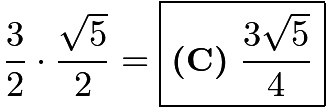2012 AMC 10A Problems/Problem 21
Problem
Let points ![]() =
= ![]() ,
, ![]() =
= ![]() ,
, ![]() =
= ![]() , and
, and ![]() =
= ![]() . Points
. Points ![]() ,
, ![]() ,
, ![]() , and
, and ![]() are midpoints of line segments
are midpoints of line segments ![]() and
and ![]() respectively. What is the area of
respectively. What is the area of ![]() ?
?
![]()
Solution 1
Consider a tetrahedron with vertices at ![]() on the
on the ![]() -plane. The length of
-plane. The length of ![]() is just one-half of
is just one-half of ![]() because it is the midsegment of
because it is the midsegment of ![]() The same concept applies to the other side lengths.
The same concept applies to the other side lengths. ![]() and
and ![]() . Then
. Then ![]() and
and ![]() . The line segments lie on perpendicular planes so quadrilateral
. The line segments lie on perpendicular planes so quadrilateral ![]() is a rectangle. The area is
is a rectangle. The area is
![]()
![[asy] import three; draw((0,0,0)--(1,0,0)--(0,0,3)--cycle); draw((0,0,0)--(0,2,0)); draw((0,2,0)--(0,0,3)); //EFGH draw((0.5,0,1.5)--(0.5,0,0)--(0,1,0)--(0,1,1.5)--(0.5,0,1.5),red); //Points label("$E$",(0.5,0,1.5),NW); label("$F$",(0.5,0,0),S); label("$G$",(0,1,0),S); label("$H$",(0,1,1.5),NE); label("$A$",(0,0,0),NE); label("$B$",(1,0,0),S); label("$C$",(0,2,0),S); label("$D$",(0,0,3),N); [/asy]](png/e93d5efaf2b0c198ac89b154f643a4524951d4ed.png)
Solution 2
Computing the points of ![]() gives
gives ![]() . The vector
. The vector ![]() is
is ![]() , while the vector
, while the vector ![]() is also
is also ![]() , meaning the two sides
, meaning the two sides ![]() and
and ![]() are parallel. Similarly, the vector
are parallel. Similarly, the vector ![]() is
is ![]() , while the vector
, while the vector ![]() is also
is also ![]() . Again, these are equal in both magnitude and direction, so
. Again, these are equal in both magnitude and direction, so ![]() and
and ![]() are parallel. Thus, figure
are parallel. Thus, figure ![]() is a parallelogram.
is a parallelogram.
Computation of vectors ![]() and
and ![]() is sufficient evidence that the figure is a parallelogram, since the vectors are not only point in the same direction, but are of the same magnitude, but the other vector
is sufficient evidence that the figure is a parallelogram, since the vectors are not only point in the same direction, but are of the same magnitude, but the other vector ![]() is needed to find the angle between the sides.
is needed to find the angle between the sides.
Taking the dot product of vector ![]() and vector
and vector ![]() gives
gives ![]() , which means the two vectors are perpendicular. (Alternately, as above, note that vector
, which means the two vectors are perpendicular. (Alternately, as above, note that vector ![]() goes directly down on the z-axis, while vector
goes directly down on the z-axis, while vector ![]() has no z-component and lie completely in the xy plane.) Thus, the figure is a parallelogram with a right angle, which makes it a rectangle. With the distance formula in three dimensions, we find that
has no z-component and lie completely in the xy plane.) Thus, the figure is a parallelogram with a right angle, which makes it a rectangle. With the distance formula in three dimensions, we find that ![]() and
and ![]() , giving an area of
, giving an area of 
Video Solution by Richard Rusczyk
https://artofproblemsolving.com/videos/amc/2012amc10a/249
~dolphin7
See Also
| 2012 AMC 10A (Problems • Answer Key • Resources) | ||
| Preceded by Problem 20 |
Followed by Problem 22 | |
| 1 • 2 • 3 • 4 • 5 • 6 • 7 • 8 • 9 • 10 • 11 • 12 • 13 • 14 • 15 • 16 • 17 • 18 • 19 • 20 • 21 • 22 • 23 • 24 • 25 | ||
| All AMC 10 Problems and Solutions | ||
The problems on this page are copyrighted by the Mathematical Association of America's American Mathematics Competitions. 
